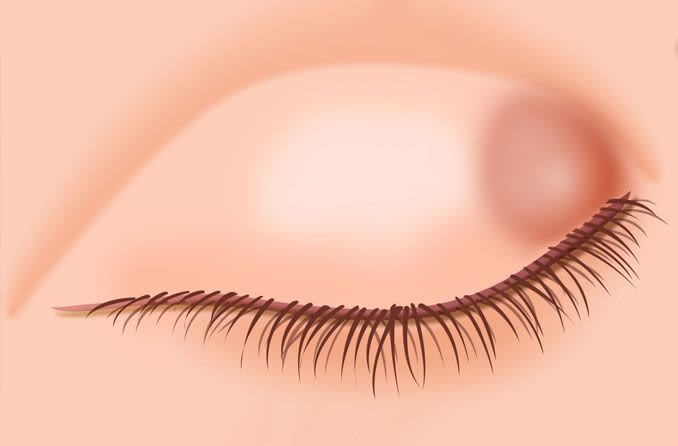How To Get Rid Of Bump On Eyelid
All About Chalazion (Bump on Eyelid)
- What is a chalazion?
- How to identify a chalazion
- What causes a chalazion?
- Treatments
- Can a chalazion be cancerous?
- Prevention

What is a chalazion?
A chalazion is a painless bump on your eyelid. It can affect the upper or lower eyelid. It is often confused with an eye stye (or hordeolum), but a chalazion is different in that it's painless and is not caused by a bacterial infection. [Chalazion is pronounced "kah-LAY-zee-on" or "shah-LAY-zee-on".]
Chalazia (plural for chalazion) are the result of healed internal styes that are no longer infectious. These cyst-like eyelid bumps form around an oil gland within the lid and can cause red, swollen eyelids.
How to identify a chalazion
The contents of a chalazion include pus and blocked fatty secretions (lipids) that normally help lubricate the eye but can no longer drain out.
Many chalazia eventually drain and heal on their own. You can help this process along by applying warm compresses to your eyelid. Gently massaging the lid can help, too.
But some chalazia can persist for several weeks or more and grow large enough to become cosmetically unappealing.
When these large, painless chalazia are left untreated, they may eventually begin to press on the cornea, temporarily causing astigmatism and blurry vision.
What causes a chalazion?
It's often impossible to know what causes a chalazion. Risk factors include blepharitis and rosacea.
People with rosacea — characterized by facial redness and swollen bumps under the skin — are prone to certain eye problems, such as blepharitis and chalazia.
Rosacea can affect eyelids, the eye's thin outer membrane (conjunctiva), the clear eye surface (cornea) and the white of the eye (sclera). Rosacea that affects the eye and surrounding tissues is called ocular rosacea.
Causes of rosacea itself can be difficult to pinpoint, although environment and inherited tendencies are likely factors. Certain microorganisms living in or near eyelash roots may also exacerbate inflammation around the eye.
Treatments
If you develop a chalazion, it's best to see an eye doctor to determine the best way to get rid of this irritating bump on your eyelid before the condition leads to further eye complications.
Warm compress
Your eye doctor can provide you with instructions for how to apply warm compresses to your eyelid to help get rid of a chalazion or other eyelid bump. If you are prone to blepharitis, instructions for routine cleaning of your eyelids also may be given.
Medication
Your doctor may also prescribe a topical medication to treat your chalazion. In some cases, oral medications may be recommended to reduce risk factors for getting chalazia.
The most commonly prescribed oral medicines for blepharitis and meibomian gland dysfunction are antibiotics such as doxycycline. But topical and oral antibiotics often are ineffective at getting rid of a chalazion.
Surgery
A small, inconspicuous chalazion may require no treatment at all. However, some chalazia do not clear up on their own. These may cause the eyelid bumps to be persistent or even grow larger. In the case of a bothersome and persistent chalazion, your eye doctor may recommend a simple in-office surgery to excise it.
An eye surgeon will use local anesthesia to numb the area before making a small incision, typically from underneath the eyelid, to clear the contents of the chalazion without visible scarring.
An alternate procedure involves injecting the chalazion with a corticosteroid. A potential side effect of steroid injection is lightening of the surrounding skin, which can be more problematic for people with darker skin tones.
Can a chalazion be cancerous?
If a chalazion recurs in the same part of the eyelid or has a suspicious appearance, the removed tissue may be sent to a laboratory to rule out cancer. Fortunately, most chalazia are benign and harmless.
Prevention
With just a few simple steps, you can help avoid a recurrence of chalazia.
-
Wash your hands thoroughly after touching surfaces that may be unclean or have been touched by many other people.
-
Avoid touching your face and eyes throughout the day unless absolutely necessary.
-
Clean your hands thoroughly before putting in and removing your contact lenses.
-
Be sure to practice good eye hygiene before bed, including removing any eye makeup or other possible irritants.
-
Never share eye makeup or any cosmetic product used near your eyes.
-
Check the expiration dates on makeup products as well as eye creams, and toss out any that have expired.
Page published in March 2019
Page updated in October 2021
How To Get Rid Of Bump On Eyelid
Source: https://www.allaboutvision.com/conditions/chalazion.htm
Posted by: campbellyeard1966.blogspot.com

0 Response to "How To Get Rid Of Bump On Eyelid"
Post a Comment